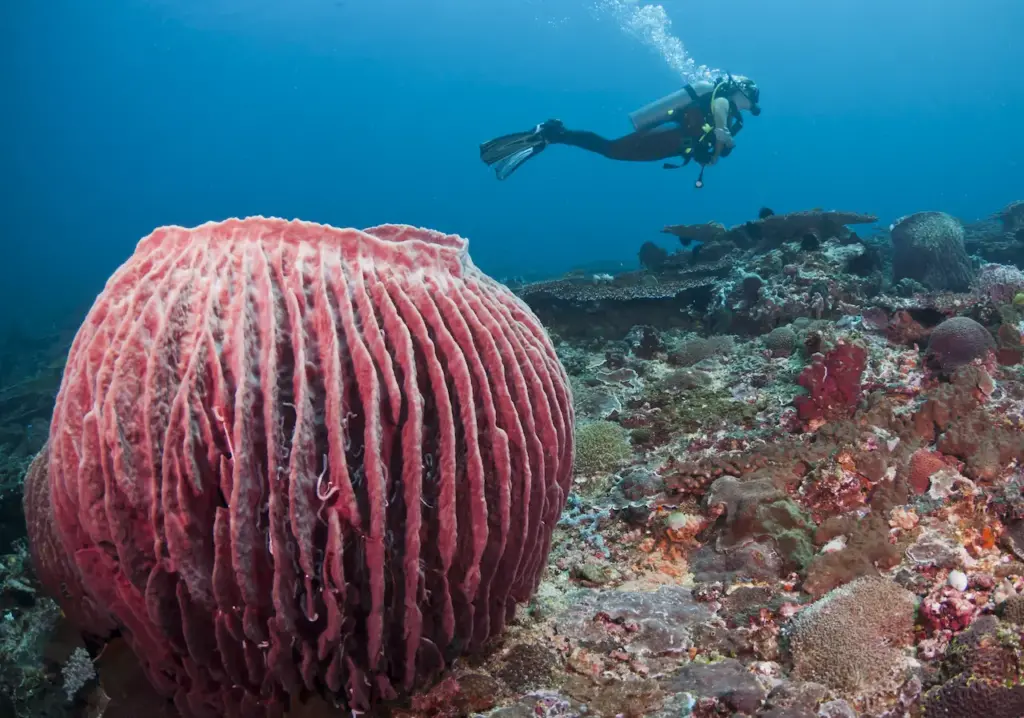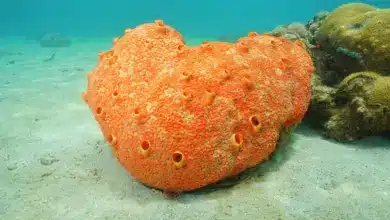Sponge vs Corals
Sponge vs Corals – The Stand Off
On the surface, there seems to be few differences between sponges and corals.
Both are immobile aquatic invertebrates. Both tend to have branching structures.
But dive deeper, and it is clear that sponges and corals are incredibly different animals.

Differences Between Sponges and Coral
Granted, both sponges and corals are part of the Animal (Animalia) Kingdom. But make no mistake, the similarities end there.
Sponges and corals are two entirely different species, occupying different phyla on the Tree of Life. Sponges belong to the phylum Porifera, while corals belong to the phylum Cnidaria (the same phyla jellyfish and hydras).
Yes, both animals may look similar, but if you really look, you may notice that corals are incredibly complex, multicellular animals made up of not a single organism, but many organisms.
Sponges, on the other hand, are incredibly primitive species. In the nicest way possible, of course.
But let’s explore this a little more.
What Is a Coral?
Let’s start with the basics.
Corals have differentiated tissue layers, and are almost always colonial organisms. This means that they are comprised of many individual, yet identical, animals, clustered together. These animal communities can range from hundreds to hundreds of thousands of individuals, called polyps.
So, corals are made of polyps. Easy, right?
But what really are polyps?
A coral polyp is an almost microscopic invertebrate, ranging from 1mm to 3mm in diameter. They are relatively simple, multicellular organisms, comprising mostly of a stomach and outer tentacles (oceanservice.gov).
The tentacles of a polyp can be found in a ring around its mouth and play an important function when it comes to feeding and protection. Within the epidermis layer of the tentacles, nematocysts, or stinging cells, are found. It is these nematocysts that help the polyp capture planktonic prey (floridakeys.gov).
Reef-building polyps secrete calcium carbonate, forming a protective casing known as a calyx, in which the polyp sits.
Polyp biology, tick. But how does this relate to corals?
Individual polyps in a coral community have a living layer of tissue called the coenosarc. This is the key to a communal lifestyle, as it connects one polyp to another. The coenosarc holds the gastrovascular canal system, allowing nutrient and information exchanges between individuals and ensuring the community continues to thrive (oceanservice.gov).
So there we have it, corals are an incredibly complex and sophisticated community of organisms.
How Do Sponges Differ From Corals?
Sponges are primitive animals, having existed in our oceans for hundreds of millions of years – considerably longer than modern corals have been around (oceanservice.gov).
Despite their long-lived oceanic existence, sponges have failed to evolve nervous, digestive, and circulatory systems. In fact, sponges have no tissues whatsoever.
But how do sponges, without these essential animal systems, survive?
Most species of sponges rely on maintaining a constant flow of water through the main opening, or osculum. This influx of water transports food and oxygen to the sponge, as well as removes waste products, eliminating the need for respiratory, digestive, and circulatory systems.
Sponges are porous animals. This means their body is covered in minuscule holes, which are lined with flagellated cells. These cells aid in the transportation of food through the pores.
Another difference between sponges and corals is that sponges contain specialised cells called choanocytes. Totipotent, choanocyte cells are capable of changing their role to perform certain functions; much like a stem cell in the mammalian body.
Of course, morphology is a big difference between these two invertebrate groups.
As we saw earlier, coral polyps produce calcium carbonate casings (hard corals only). This is a hard substance, also referred to as limestone.
On the other hand, sponges are often comprised of a soft-bodied exterior. The basic skeletal structure is made by cells known as amoebocytes. These construction cells produce spongin; a soft, flexible fibre (manoa.edu).
Symbiosis Within Coral and Sponges
Symbiosis is an ecological relationship between two or more species. In nature, there are multiple forms of symbiosis, including:
- Mutualism – beneficial for all species involved
- Commensalism – one species benefits, another is unaffected
- Parasitism – one species benefits, others are harmed.
Sponges and corals have a mutualistic relationship with different species.
Sponges have evolved symbiotic relationships with a wide range of organisms, including algae, bacteria, crustaceans, fish, and more.
This relationship benefits both sponges and other organisms for food and protection.
However, corals take symbiosis to the next level.
Some 210 million years ago, a relationship between algae and modern corals evolved. This has been one of the most significant evolution events, as it has allowed for the mass expansion of coral reefs. This, in turn, has allowed an influx in biodiversity (princeton.edu).
But how does this relationship work?
It all begins with a specific species of algae: zooxanthellae.
Found living within the tissues of a coral (remember, sponges do not have tissues, so the type of symbiosis is incredibly different), most reef-building corals contain zooxanthellae (oceanservice.gov).
But this isn’t some kind of scary, parasitic growth living within the tissues of another organism.
Quite the opposite. The relationship between the coral and zooxanthellae is a mutualistic one, meaning both parties benefit.
The coral provides the algae with an enclosed, protective environment, out of harm’s way. In return, the zooxanthellae produce vital oxygen, as well as important compounds such as glucose and amino acids, through the product of photosynthesis.
Nutrient recycling is also a huge part of the mutualistic relationship.
Despite their high productivity and biodiversity, tropical coral reefs are highly nutrient-deficient. So how do corals thrive in such nutrient-poor waters?
It is thought that as much as 90% of the organic materials (proteins, fats, and carbohydrates) produced from the photosynthesis process of zooxanthellae go directly into the host coral. This accelerates the growth and production of coral reefs (oceanservice.gov).
Conclusion
Sponges are primitive animals from the phylum Porifera. They are often soft-bodied, due to flexible amoebocyte cells.
Corals are marine invertebrates from the phylum Cnidaria. Corals are comprised of thousands of individual organisms, or polyps, to form expansive reef systems.
Both species use mutualistic symbiosis, however, corals rely on zooxanthellae algae for survival.

